Management Accounting Report: XYZ Ltd, Budgeting, and Costing Analysis
VerifiedAdded on 2023/02/02
|16
|3624
|49
Report
AI Summary
This report provides a comprehensive analysis of management accounting principles, focusing on XYZ Ltd., a chair manufacturing company. It begins with an introduction to management accounting and its importance in business decision-making. The report then delves into the practical application of marginal and absorption costing methods, presenting income statements for three years using both approaches. Detailed calculations and interpretations are provided, highlighting the differences in profit figures generated by each costing method. Furthermore, the report examines the advantages and disadvantages of various budgeting control techniques, such as fixed budgets. The analysis provides insights into how these techniques can be used to manage and control business activities. The report concludes with a discussion on the differences between marginal and absorption costing and the implications of these differences in business decision-making.
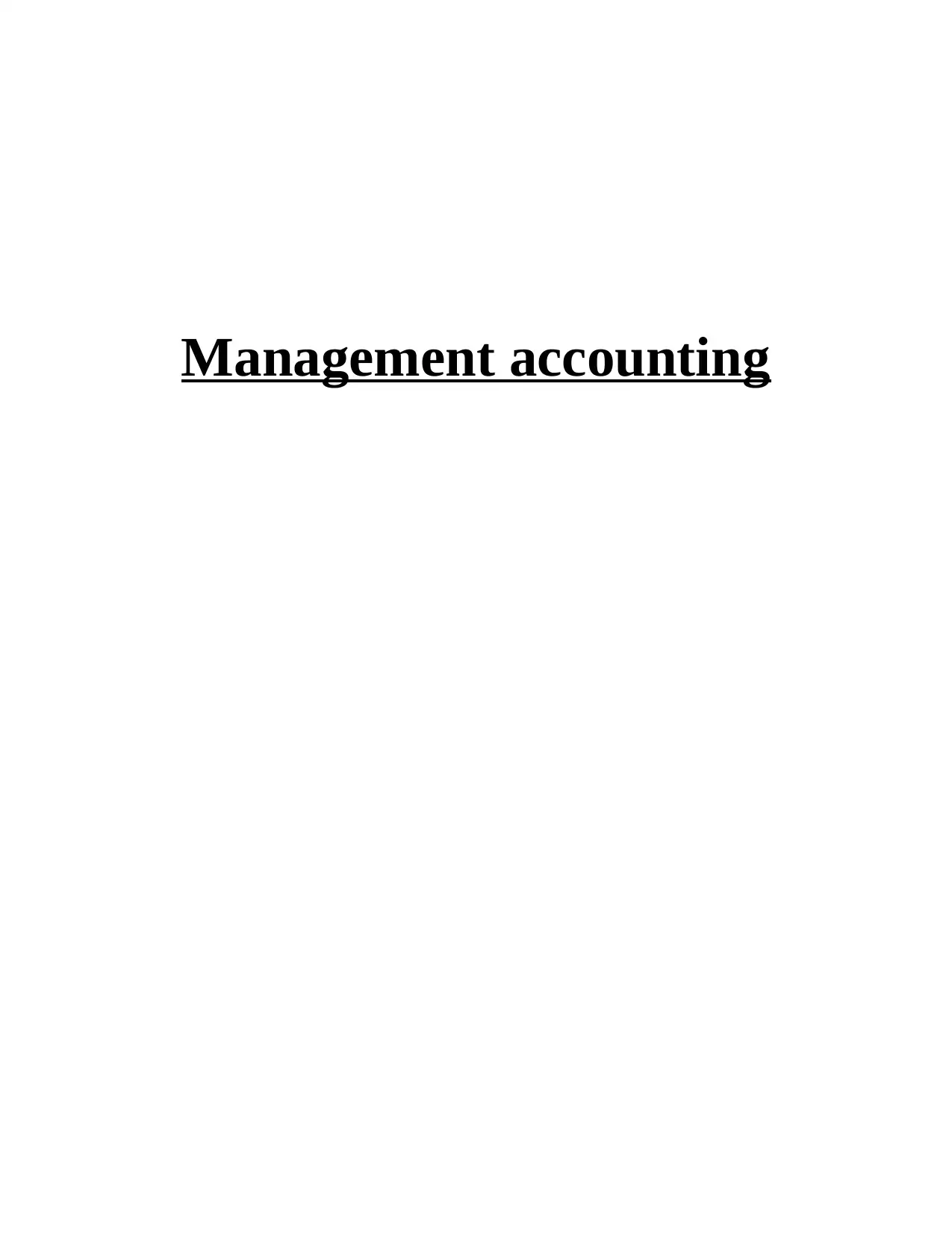
Management accounting
Paraphrase This Document
Need a fresh take? Get an instant paraphrase of this document with our AI Paraphraser
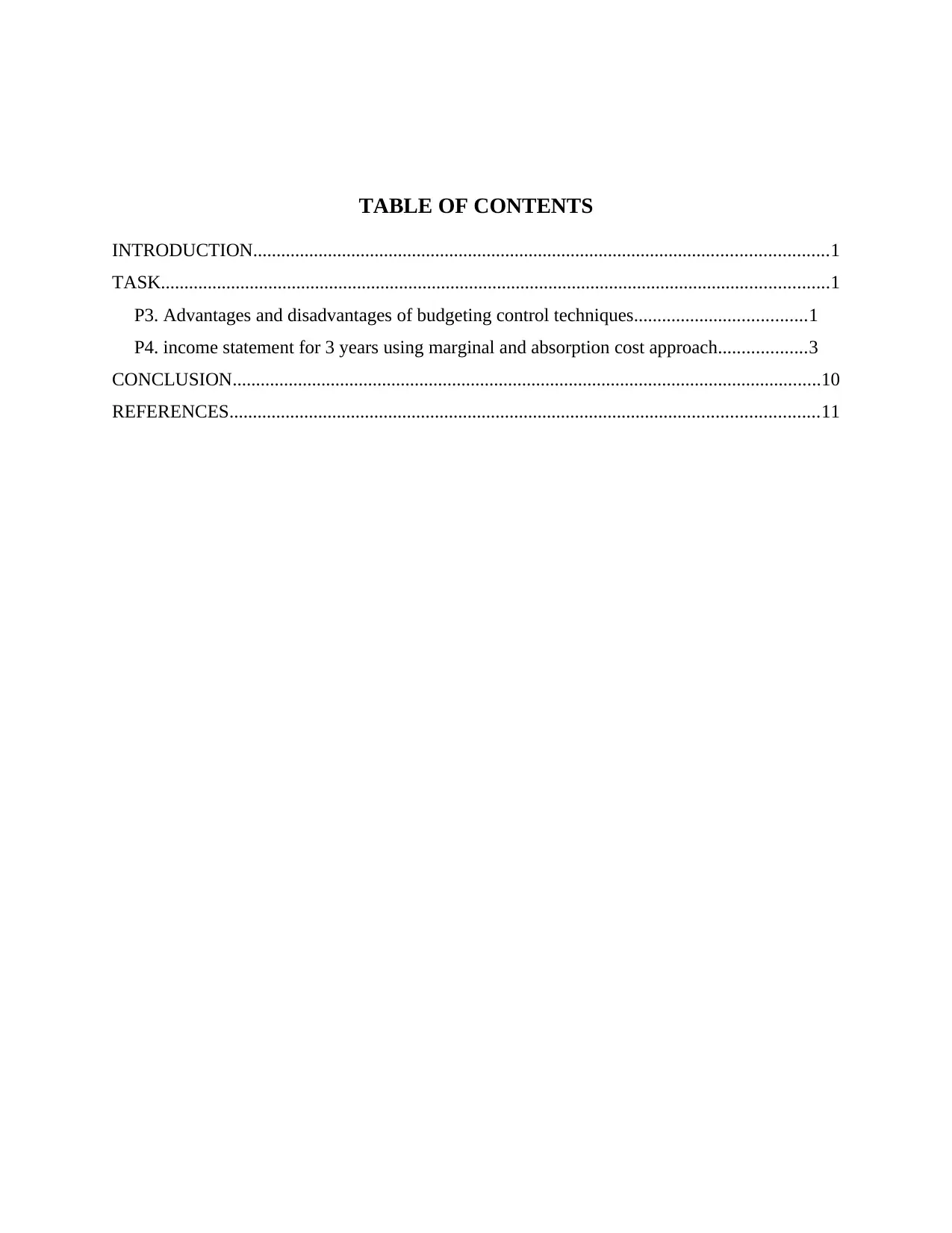
TABLE OF CONTENTS
INTRODUCTION...........................................................................................................................1
TASK...............................................................................................................................................1
P3. Advantages and disadvantages of budgeting control techniques.....................................1
P4. income statement for 3 years using marginal and absorption cost approach...................3
CONCLUSION..............................................................................................................................10
REFERENCES..............................................................................................................................11
INTRODUCTION...........................................................................................................................1
TASK...............................................................................................................................................1
P3. Advantages and disadvantages of budgeting control techniques.....................................1
P4. income statement for 3 years using marginal and absorption cost approach...................3
CONCLUSION..............................................................................................................................10
REFERENCES..............................................................................................................................11

INTRODUCTION
Management accounting is the process of assessing the business activities of the internal
management so that better decision making can be done. Management and accounting reports are
prepared so that company could analyse its profits and can compare it with past year's data.
Present study is based on XYZ ltd., a chair manufacturing company and will explain the
advantage and disadvantage of budgeting control tools. Furthermore, it will calculate net profit
by using marginal and absorption costing approach for 3 years’ business of XYZ ltd.
TASK
P3. Income statement for 3 years using marginal and absorption cost approach
USING MARGINAL COST APPROACH-
Income statement for the year ended 1
( using marginal approach)
ITEMS
NO. OF
UNITS
PER
UNIT
AMT.(in
pounds)
TOTAL AMT.
(in pounds)
sales 36000 70 2520000
Marginal cost of sales (MCOS)
Stock at beginning(opening stock)
add: variable production cost:-
direct material(DMC) 40000 12 480000
direct labour(DLC) 40000 16 640000
variable expenses(VC) 40000 20 800000
Total variable cost A 40000 48 1920000
less:closing stock at the end of the year B
(opening stock units+units produced-
units sold) 4000 48 192000
Marginal cost of sales(MCOS) A-B 1728000
Fixed indirect production cost 64000
Gross profit: (sales- marginal cost of
sales- Fixed production cost) 728000
1
Management accounting is the process of assessing the business activities of the internal
management so that better decision making can be done. Management and accounting reports are
prepared so that company could analyse its profits and can compare it with past year's data.
Present study is based on XYZ ltd., a chair manufacturing company and will explain the
advantage and disadvantage of budgeting control tools. Furthermore, it will calculate net profit
by using marginal and absorption costing approach for 3 years’ business of XYZ ltd.
TASK
P3. Income statement for 3 years using marginal and absorption cost approach
USING MARGINAL COST APPROACH-
Income statement for the year ended 1
( using marginal approach)
ITEMS
NO. OF
UNITS
PER
UNIT
AMT.(in
pounds)
TOTAL AMT.
(in pounds)
sales 36000 70 2520000
Marginal cost of sales (MCOS)
Stock at beginning(opening stock)
add: variable production cost:-
direct material(DMC) 40000 12 480000
direct labour(DLC) 40000 16 640000
variable expenses(VC) 40000 20 800000
Total variable cost A 40000 48 1920000
less:closing stock at the end of the year B
(opening stock units+units produced-
units sold) 4000 48 192000
Marginal cost of sales(MCOS) A-B 1728000
Fixed indirect production cost 64000
Gross profit: (sales- marginal cost of
sales- Fixed production cost) 728000
1
⊘ This is a preview!⊘
Do you want full access?
Subscribe today to unlock all pages.

Trusted by 1+ million students worldwide
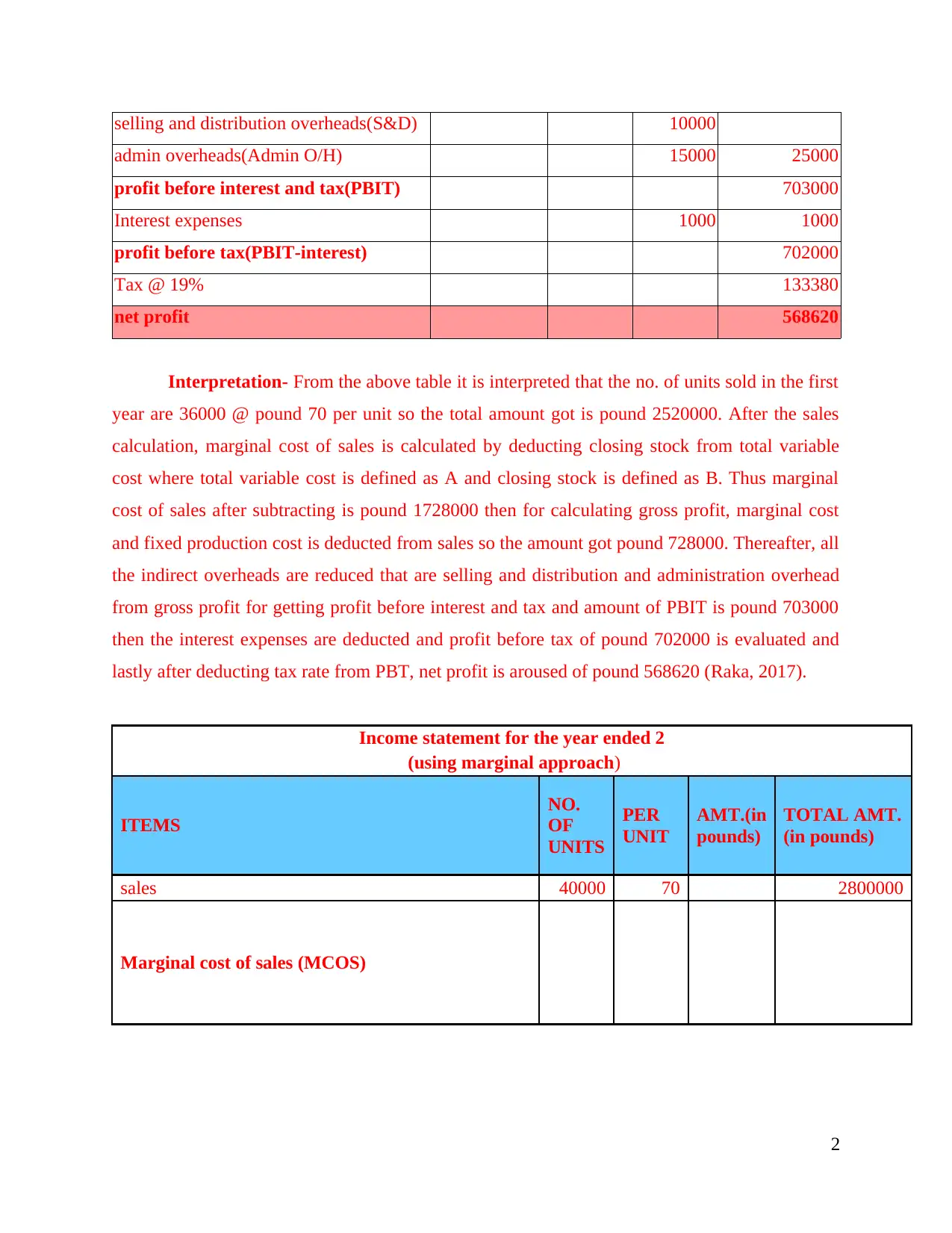
selling and distribution overheads(S&D) 10000
admin overheads(Admin O/H) 15000 25000
profit before interest and tax(PBIT) 703000
Interest expenses 1000 1000
profit before tax(PBIT-interest) 702000
Tax @ 19% 133380
net profit 568620
Interpretation- From the above table it is interpreted that the no. of units sold in the first
year are 36000 @ pound 70 per unit so the total amount got is pound 2520000. After the sales
calculation, marginal cost of sales is calculated by deducting closing stock from total variable
cost where total variable cost is defined as A and closing stock is defined as B. Thus marginal
cost of sales after subtracting is pound 1728000 then for calculating gross profit, marginal cost
and fixed production cost is deducted from sales so the amount got pound 728000. Thereafter, all
the indirect overheads are reduced that are selling and distribution and administration overhead
from gross profit for getting profit before interest and tax and amount of PBIT is pound 703000
then the interest expenses are deducted and profit before tax of pound 702000 is evaluated and
lastly after deducting tax rate from PBT, net profit is aroused of pound 568620 (Raka, 2017).
Income statement for the year ended 2
(using marginal approach)
ITEMS
NO.
OF
UNITS
PER
UNIT
AMT.(in
pounds)
TOTAL AMT.
(in pounds)
sales 40000 70 2800000
Marginal cost of sales (MCOS)
2
admin overheads(Admin O/H) 15000 25000
profit before interest and tax(PBIT) 703000
Interest expenses 1000 1000
profit before tax(PBIT-interest) 702000
Tax @ 19% 133380
net profit 568620
Interpretation- From the above table it is interpreted that the no. of units sold in the first
year are 36000 @ pound 70 per unit so the total amount got is pound 2520000. After the sales
calculation, marginal cost of sales is calculated by deducting closing stock from total variable
cost where total variable cost is defined as A and closing stock is defined as B. Thus marginal
cost of sales after subtracting is pound 1728000 then for calculating gross profit, marginal cost
and fixed production cost is deducted from sales so the amount got pound 728000. Thereafter, all
the indirect overheads are reduced that are selling and distribution and administration overhead
from gross profit for getting profit before interest and tax and amount of PBIT is pound 703000
then the interest expenses are deducted and profit before tax of pound 702000 is evaluated and
lastly after deducting tax rate from PBT, net profit is aroused of pound 568620 (Raka, 2017).
Income statement for the year ended 2
(using marginal approach)
ITEMS
NO.
OF
UNITS
PER
UNIT
AMT.(in
pounds)
TOTAL AMT.
(in pounds)
sales 40000 70 2800000
Marginal cost of sales (MCOS)
2
Paraphrase This Document
Need a fresh take? Get an instant paraphrase of this document with our AI Paraphraser
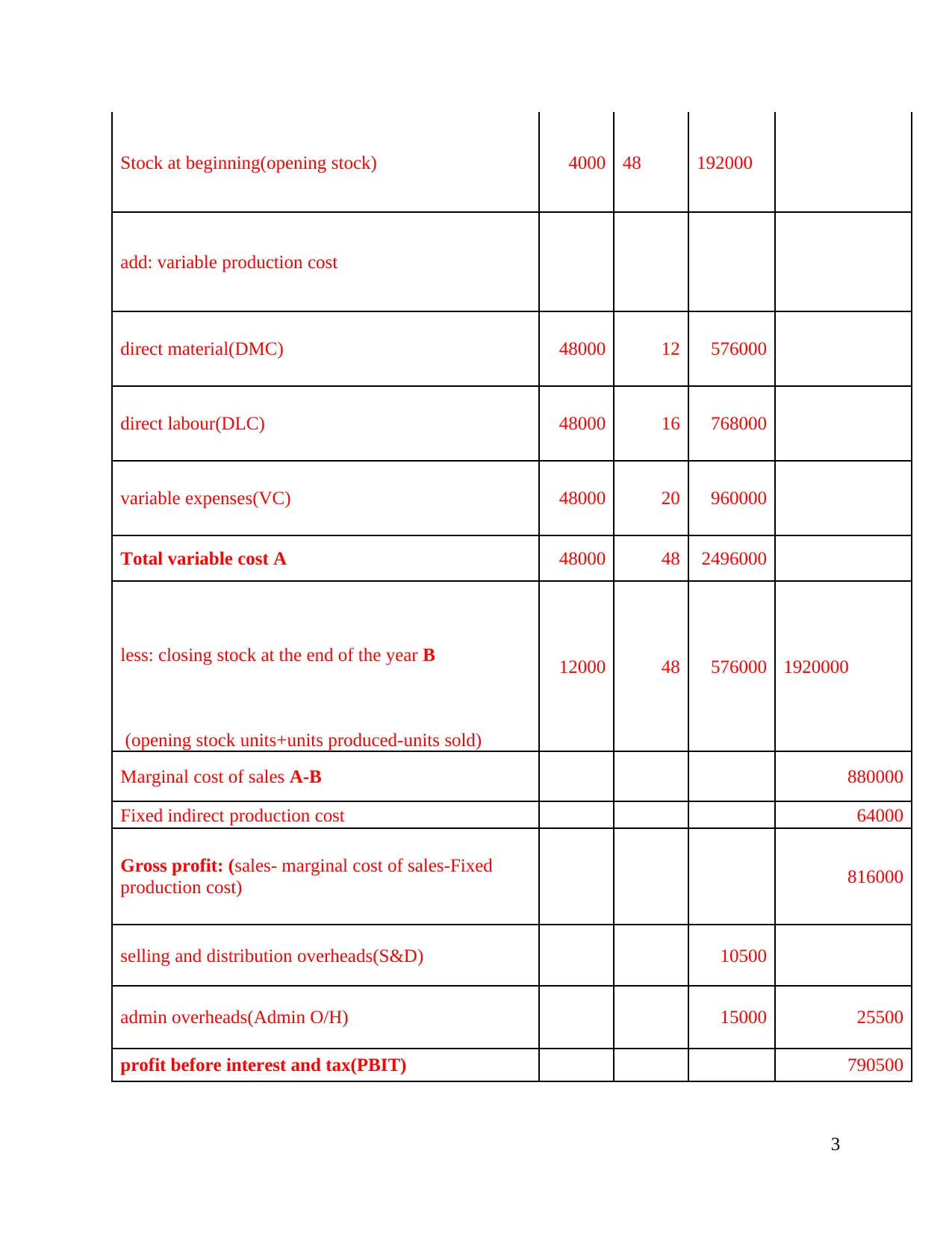
Stock at beginning(opening stock) 4000 48 192000
add: variable production cost
direct material(DMC) 48000 12 576000
direct labour(DLC) 48000 16 768000
variable expenses(VC) 48000 20 960000
Total variable cost A 48000 48 2496000
less: closing stock at the end of the year B 12000 48 576000 1920000
(opening stock units+units produced-units sold)
Marginal cost of sales A-B 880000
Fixed indirect production cost 64000
Gross profit: (sales- marginal cost of sales-Fixed
production cost) 816000
selling and distribution overheads(S&D) 10500
admin overheads(Admin O/H) 15000 25500
profit before interest and tax(PBIT) 790500
3
add: variable production cost
direct material(DMC) 48000 12 576000
direct labour(DLC) 48000 16 768000
variable expenses(VC) 48000 20 960000
Total variable cost A 48000 48 2496000
less: closing stock at the end of the year B 12000 48 576000 1920000
(opening stock units+units produced-units sold)
Marginal cost of sales A-B 880000
Fixed indirect production cost 64000
Gross profit: (sales- marginal cost of sales-Fixed
production cost) 816000
selling and distribution overheads(S&D) 10500
admin overheads(Admin O/H) 15000 25500
profit before interest and tax(PBIT) 790500
3
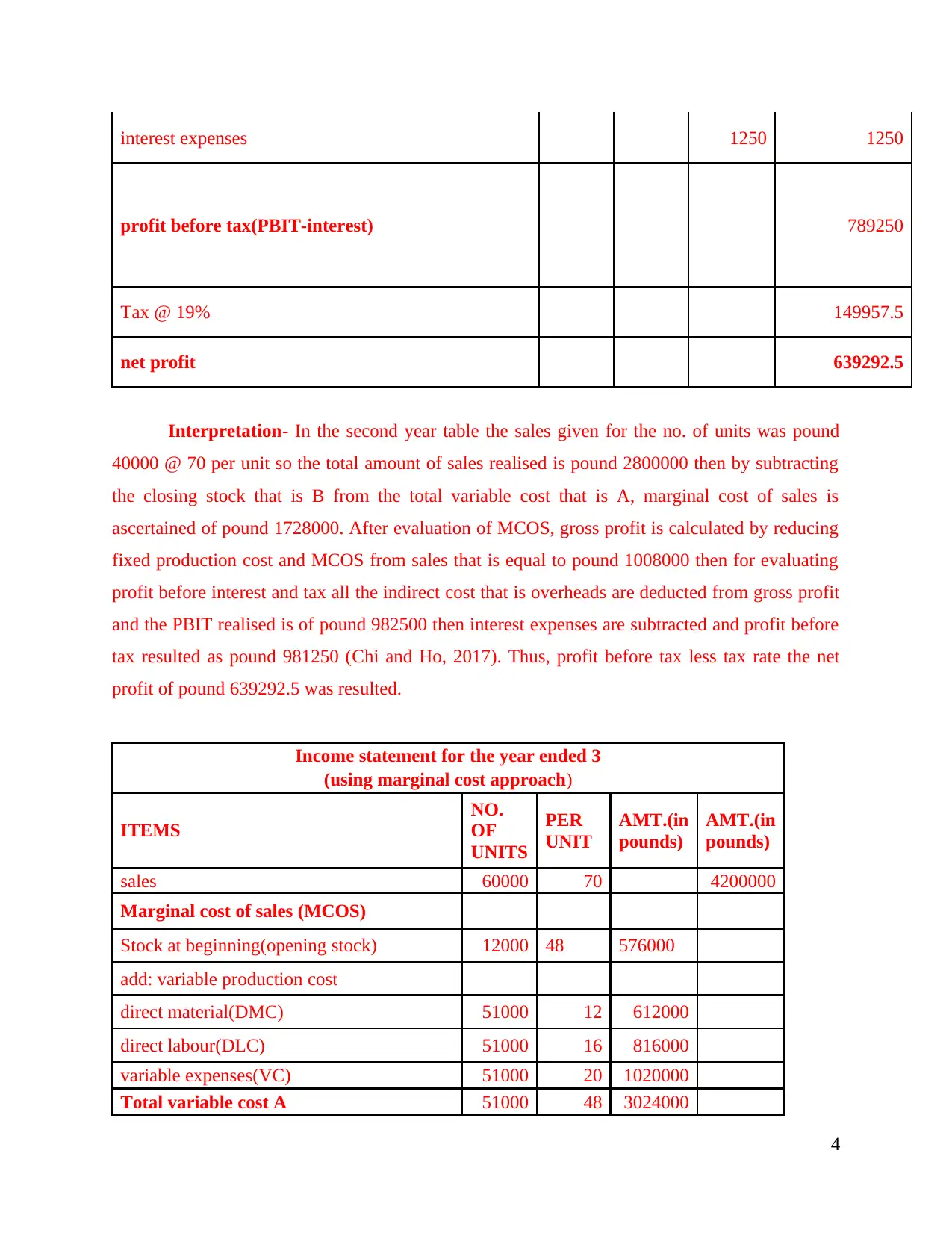
interest expenses 1250 1250
profit before tax(PBIT-interest) 789250
Tax @ 19% 149957.5
net profit 639292.5
Interpretation- In the second year table the sales given for the no. of units was pound
40000 @ 70 per unit so the total amount of sales realised is pound 2800000 then by subtracting
the closing stock that is B from the total variable cost that is A, marginal cost of sales is
ascertained of pound 1728000. After evaluation of MCOS, gross profit is calculated by reducing
fixed production cost and MCOS from sales that is equal to pound 1008000 then for evaluating
profit before interest and tax all the indirect cost that is overheads are deducted from gross profit
and the PBIT realised is of pound 982500 then interest expenses are subtracted and profit before
tax resulted as pound 981250 (Chi and Ho, 2017). Thus, profit before tax less tax rate the net
profit of pound 639292.5 was resulted.
Income statement for the year ended 3
(using marginal cost approach)
ITEMS
NO.
OF
UNITS
PER
UNIT
AMT.(in
pounds)
AMT.(in
pounds)
sales 60000 70 4200000
Marginal cost of sales (MCOS)
Stock at beginning(opening stock) 12000 48 576000
add: variable production cost
direct material(DMC) 51000 12 612000
direct labour(DLC) 51000 16 816000
variable expenses(VC) 51000 20 1020000
Total variable cost A 51000 48 3024000
4
profit before tax(PBIT-interest) 789250
Tax @ 19% 149957.5
net profit 639292.5
Interpretation- In the second year table the sales given for the no. of units was pound
40000 @ 70 per unit so the total amount of sales realised is pound 2800000 then by subtracting
the closing stock that is B from the total variable cost that is A, marginal cost of sales is
ascertained of pound 1728000. After evaluation of MCOS, gross profit is calculated by reducing
fixed production cost and MCOS from sales that is equal to pound 1008000 then for evaluating
profit before interest and tax all the indirect cost that is overheads are deducted from gross profit
and the PBIT realised is of pound 982500 then interest expenses are subtracted and profit before
tax resulted as pound 981250 (Chi and Ho, 2017). Thus, profit before tax less tax rate the net
profit of pound 639292.5 was resulted.
Income statement for the year ended 3
(using marginal cost approach)
ITEMS
NO.
OF
UNITS
PER
UNIT
AMT.(in
pounds)
AMT.(in
pounds)
sales 60000 70 4200000
Marginal cost of sales (MCOS)
Stock at beginning(opening stock) 12000 48 576000
add: variable production cost
direct material(DMC) 51000 12 612000
direct labour(DLC) 51000 16 816000
variable expenses(VC) 51000 20 1020000
Total variable cost A 51000 48 3024000
4
⊘ This is a preview!⊘
Do you want full access?
Subscribe today to unlock all pages.

Trusted by 1+ million students worldwide
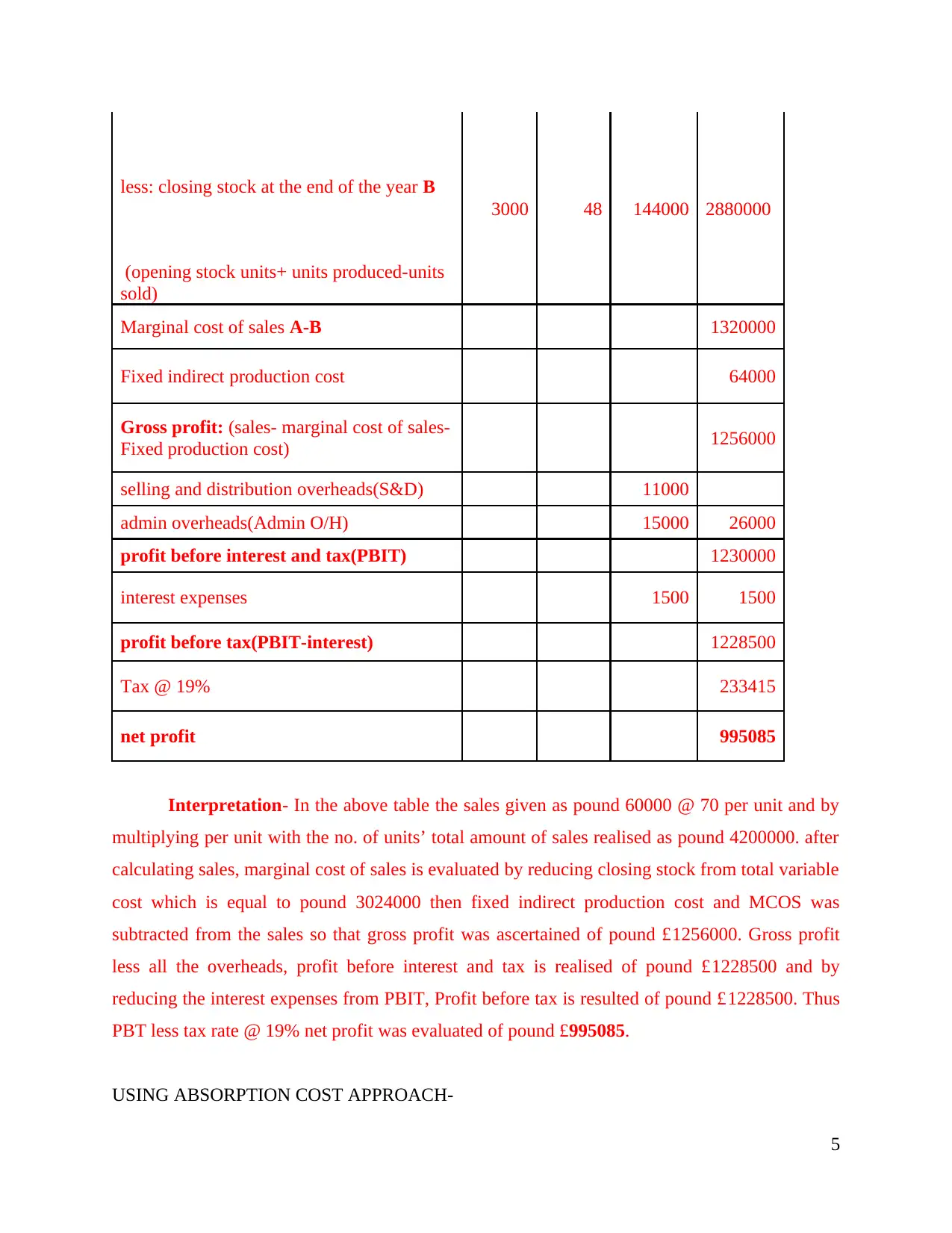
less: closing stock at the end of the year B
3000 48 144000 2880000
(opening stock units+ units produced-units
sold)
Marginal cost of sales A-B 1320000
Fixed indirect production cost 64000
Gross profit: (sales- marginal cost of sales-
Fixed production cost) 1256000
selling and distribution overheads(S&D) 11000
admin overheads(Admin O/H) 15000 26000
profit before interest and tax(PBIT) 1230000
interest expenses 1500 1500
profit before tax(PBIT-interest) 1228500
Tax @ 19% 233415
net profit 995085
Interpretation- In the above table the sales given as pound 60000 @ 70 per unit and by
multiplying per unit with the no. of units’ total amount of sales realised as pound 4200000. after
calculating sales, marginal cost of sales is evaluated by reducing closing stock from total variable
cost which is equal to pound 3024000 then fixed indirect production cost and MCOS was
subtracted from the sales so that gross profit was ascertained of pound £1256000. Gross profit
less all the overheads, profit before interest and tax is realised of pound £1228500 and by
reducing the interest expenses from PBIT, Profit before tax is resulted of pound £1228500. Thus
PBT less tax rate @ 19% net profit was evaluated of pound £995085.
USING ABSORPTION COST APPROACH-
5
3000 48 144000 2880000
(opening stock units+ units produced-units
sold)
Marginal cost of sales A-B 1320000
Fixed indirect production cost 64000
Gross profit: (sales- marginal cost of sales-
Fixed production cost) 1256000
selling and distribution overheads(S&D) 11000
admin overheads(Admin O/H) 15000 26000
profit before interest and tax(PBIT) 1230000
interest expenses 1500 1500
profit before tax(PBIT-interest) 1228500
Tax @ 19% 233415
net profit 995085
Interpretation- In the above table the sales given as pound 60000 @ 70 per unit and by
multiplying per unit with the no. of units’ total amount of sales realised as pound 4200000. after
calculating sales, marginal cost of sales is evaluated by reducing closing stock from total variable
cost which is equal to pound 3024000 then fixed indirect production cost and MCOS was
subtracted from the sales so that gross profit was ascertained of pound £1256000. Gross profit
less all the overheads, profit before interest and tax is realised of pound £1228500 and by
reducing the interest expenses from PBIT, Profit before tax is resulted of pound £1228500. Thus
PBT less tax rate @ 19% net profit was evaluated of pound £995085.
USING ABSORPTION COST APPROACH-
5
Paraphrase This Document
Need a fresh take? Get an instant paraphrase of this document with our AI Paraphraser
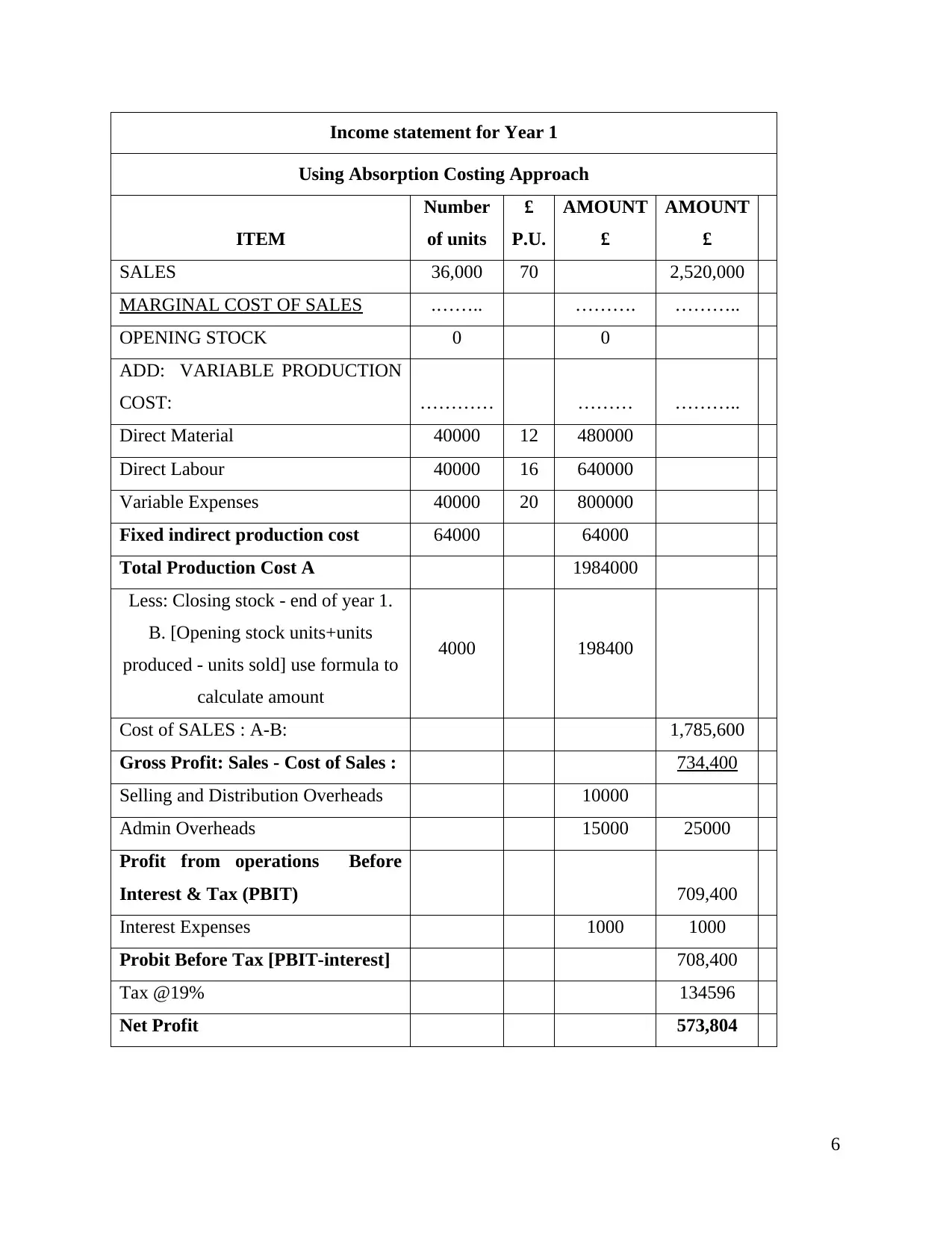
Income statement for Year 1
Using Absorption Costing Approach
ITEM
Number
of units
£
P.U.
AMOUNT
£
AMOUNT
£
SALES 36,000 70 2,520,000
MARGINAL COST OF SALES .…….. ………. ………..
OPENING STOCK 0 0
ADD: VARIABLE PRODUCTION
COST: ………… ……… ………..
Direct Material 40000 12 480000
Direct Labour 40000 16 640000
Variable Expenses 40000 20 800000
Fixed indirect production cost 64000 64000
Total Production Cost A 1984000
Less: Closing stock - end of year 1.
B. [Opening stock units+units
produced - units sold] use formula to
calculate amount
4000 198400
Cost of SALES : A-B: 1,785,600
Gross Profit: Sales - Cost of Sales : 734,400
Selling and Distribution Overheads 10000
Admin Overheads 15000 25000
Profit from operations Before
Interest & Tax (PBIT) 709,400
Interest Expenses 1000 1000
Probit Before Tax [PBIT-interest] 708,400
Tax @19% 134596
Net Profit 573,804
6
Using Absorption Costing Approach
ITEM
Number
of units
£
P.U.
AMOUNT
£
AMOUNT
£
SALES 36,000 70 2,520,000
MARGINAL COST OF SALES .…….. ………. ………..
OPENING STOCK 0 0
ADD: VARIABLE PRODUCTION
COST: ………… ……… ………..
Direct Material 40000 12 480000
Direct Labour 40000 16 640000
Variable Expenses 40000 20 800000
Fixed indirect production cost 64000 64000
Total Production Cost A 1984000
Less: Closing stock - end of year 1.
B. [Opening stock units+units
produced - units sold] use formula to
calculate amount
4000 198400
Cost of SALES : A-B: 1,785,600
Gross Profit: Sales - Cost of Sales : 734,400
Selling and Distribution Overheads 10000
Admin Overheads 15000 25000
Profit from operations Before
Interest & Tax (PBIT) 709,400
Interest Expenses 1000 1000
Probit Before Tax [PBIT-interest] 708,400
Tax @19% 134596
Net Profit 573,804
6
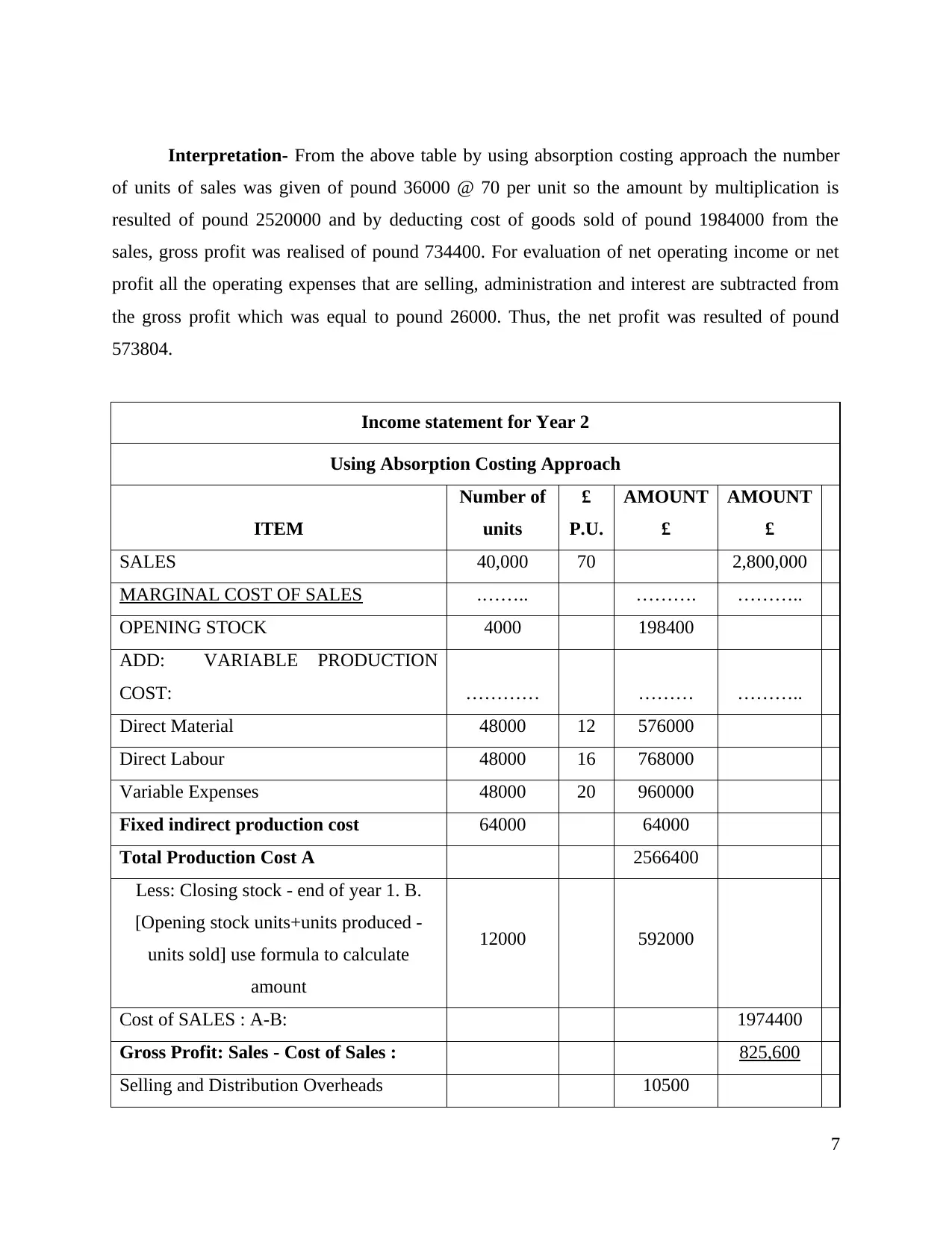
Interpretation- From the above table by using absorption costing approach the number
of units of sales was given of pound 36000 @ 70 per unit so the amount by multiplication is
resulted of pound 2520000 and by deducting cost of goods sold of pound 1984000 from the
sales, gross profit was realised of pound 734400. For evaluation of net operating income or net
profit all the operating expenses that are selling, administration and interest are subtracted from
the gross profit which was equal to pound 26000. Thus, the net profit was resulted of pound
573804.
Income statement for Year 2
Using Absorption Costing Approach
ITEM
Number of
units
£
P.U.
AMOUNT
£
AMOUNT
£
SALES 40,000 70 2,800,000
MARGINAL COST OF SALES .…….. ………. ………..
OPENING STOCK 4000 198400
ADD: VARIABLE PRODUCTION
COST: ………… ……… ………..
Direct Material 48000 12 576000
Direct Labour 48000 16 768000
Variable Expenses 48000 20 960000
Fixed indirect production cost 64000 64000
Total Production Cost A 2566400
Less: Closing stock - end of year 1. B.
[Opening stock units+units produced -
units sold] use formula to calculate
amount
12000 592000
Cost of SALES : A-B: 1974400
Gross Profit: Sales - Cost of Sales : 825,600
Selling and Distribution Overheads 10500
7
of units of sales was given of pound 36000 @ 70 per unit so the amount by multiplication is
resulted of pound 2520000 and by deducting cost of goods sold of pound 1984000 from the
sales, gross profit was realised of pound 734400. For evaluation of net operating income or net
profit all the operating expenses that are selling, administration and interest are subtracted from
the gross profit which was equal to pound 26000. Thus, the net profit was resulted of pound
573804.
Income statement for Year 2
Using Absorption Costing Approach
ITEM
Number of
units
£
P.U.
AMOUNT
£
AMOUNT
£
SALES 40,000 70 2,800,000
MARGINAL COST OF SALES .…….. ………. ………..
OPENING STOCK 4000 198400
ADD: VARIABLE PRODUCTION
COST: ………… ……… ………..
Direct Material 48000 12 576000
Direct Labour 48000 16 768000
Variable Expenses 48000 20 960000
Fixed indirect production cost 64000 64000
Total Production Cost A 2566400
Less: Closing stock - end of year 1. B.
[Opening stock units+units produced -
units sold] use formula to calculate
amount
12000 592000
Cost of SALES : A-B: 1974400
Gross Profit: Sales - Cost of Sales : 825,600
Selling and Distribution Overheads 10500
7
⊘ This is a preview!⊘
Do you want full access?
Subscribe today to unlock all pages.

Trusted by 1+ million students worldwide
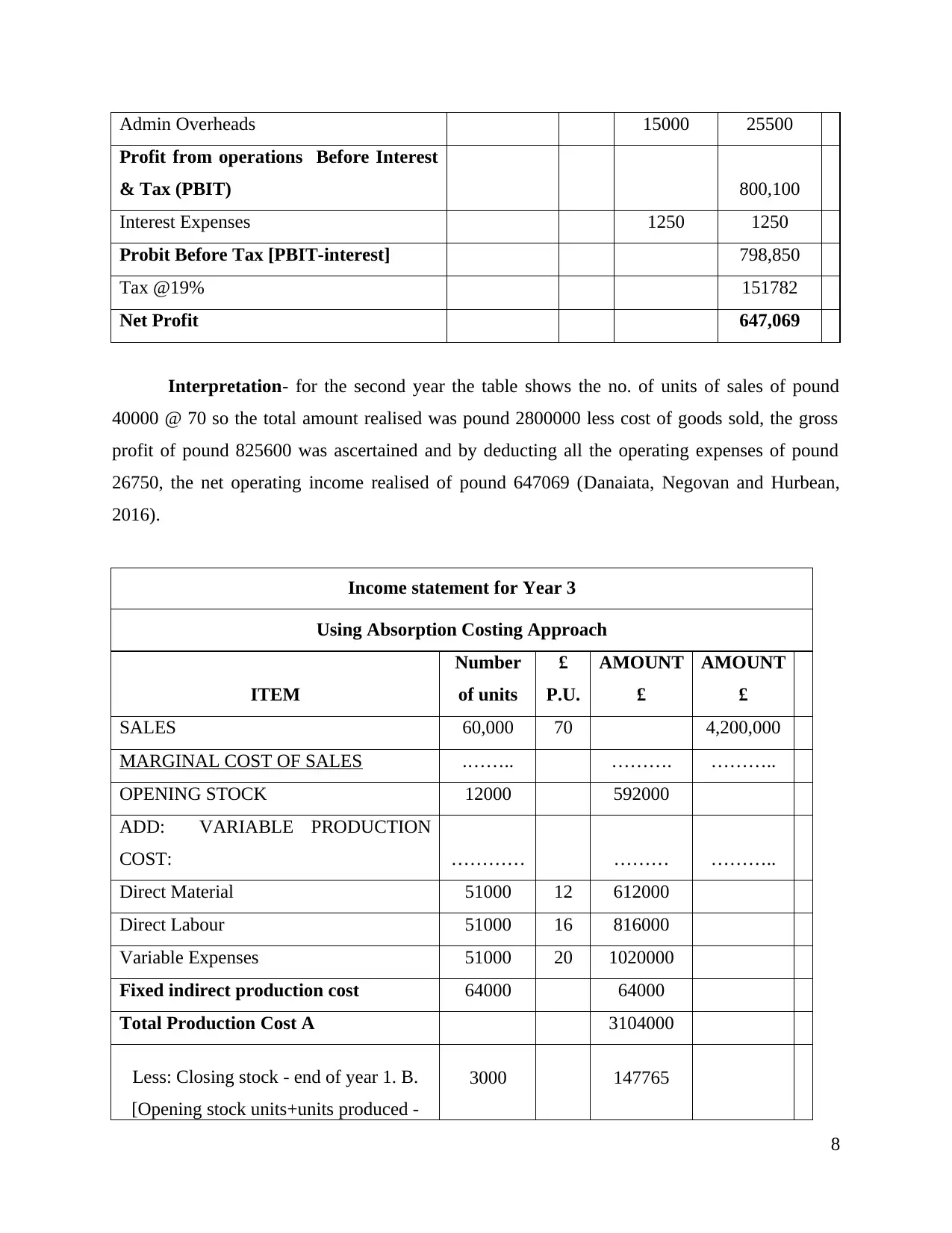
Admin Overheads 15000 25500
Profit from operations Before Interest
& Tax (PBIT) 800,100
Interest Expenses 1250 1250
Probit Before Tax [PBIT-interest] 798,850
Tax @19% 151782
Net Profit 647,069
Interpretation- for the second year the table shows the no. of units of sales of pound
40000 @ 70 so the total amount realised was pound 2800000 less cost of goods sold, the gross
profit of pound 825600 was ascertained and by deducting all the operating expenses of pound
26750, the net operating income realised of pound 647069 (Danaiata, Negovan and Hurbean,
2016).
Income statement for Year 3
Using Absorption Costing Approach
ITEM
Number
of units
£
P.U.
AMOUNT
£
AMOUNT
£
SALES 60,000 70 4,200,000
MARGINAL COST OF SALES .…….. ………. ………..
OPENING STOCK 12000 592000
ADD: VARIABLE PRODUCTION
COST: ………… ……… ………..
Direct Material 51000 12 612000
Direct Labour 51000 16 816000
Variable Expenses 51000 20 1020000
Fixed indirect production cost 64000 64000
Total Production Cost A 3104000
Less: Closing stock - end of year 1. B.
[Opening stock units+units produced -
3000 147765
8
Profit from operations Before Interest
& Tax (PBIT) 800,100
Interest Expenses 1250 1250
Probit Before Tax [PBIT-interest] 798,850
Tax @19% 151782
Net Profit 647,069
Interpretation- for the second year the table shows the no. of units of sales of pound
40000 @ 70 so the total amount realised was pound 2800000 less cost of goods sold, the gross
profit of pound 825600 was ascertained and by deducting all the operating expenses of pound
26750, the net operating income realised of pound 647069 (Danaiata, Negovan and Hurbean,
2016).
Income statement for Year 3
Using Absorption Costing Approach
ITEM
Number
of units
£
P.U.
AMOUNT
£
AMOUNT
£
SALES 60,000 70 4,200,000
MARGINAL COST OF SALES .…….. ………. ………..
OPENING STOCK 12000 592000
ADD: VARIABLE PRODUCTION
COST: ………… ……… ………..
Direct Material 51000 12 612000
Direct Labour 51000 16 816000
Variable Expenses 51000 20 1020000
Fixed indirect production cost 64000 64000
Total Production Cost A 3104000
Less: Closing stock - end of year 1. B.
[Opening stock units+units produced -
3000 147765
8
Paraphrase This Document
Need a fresh take? Get an instant paraphrase of this document with our AI Paraphraser
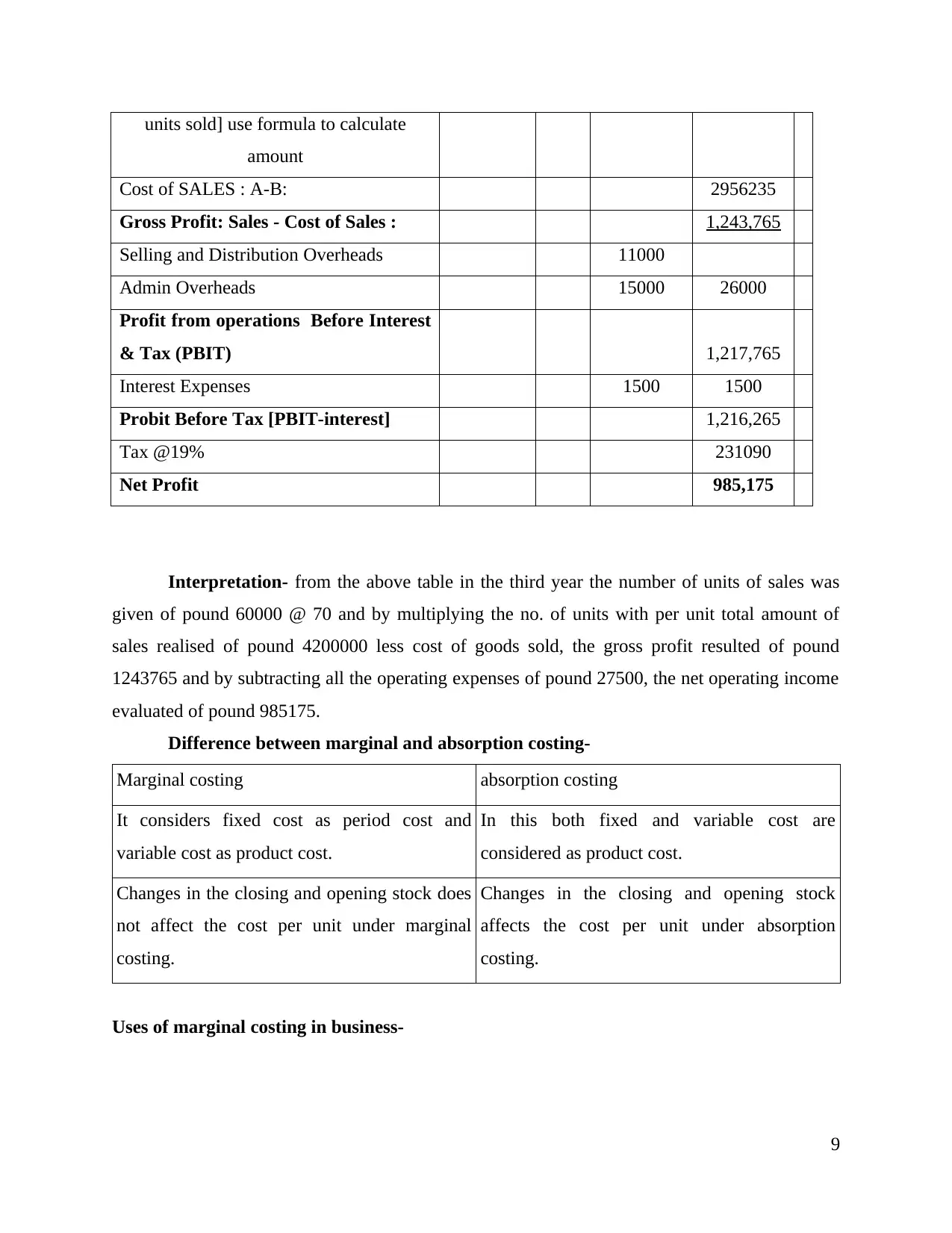
units sold] use formula to calculate
amount
Cost of SALES : A-B: 2956235
Gross Profit: Sales - Cost of Sales : 1,243,765
Selling and Distribution Overheads 11000
Admin Overheads 15000 26000
Profit from operations Before Interest
& Tax (PBIT) 1,217,765
Interest Expenses 1500 1500
Probit Before Tax [PBIT-interest] 1,216,265
Tax @19% 231090
Net Profit 985,175
Interpretation- from the above table in the third year the number of units of sales was
given of pound 60000 @ 70 and by multiplying the no. of units with per unit total amount of
sales realised of pound 4200000 less cost of goods sold, the gross profit resulted of pound
1243765 and by subtracting all the operating expenses of pound 27500, the net operating income
evaluated of pound 985175.
Difference between marginal and absorption costing-
Marginal costing absorption costing
It considers fixed cost as period cost and
variable cost as product cost.
In this both fixed and variable cost are
considered as product cost.
Changes in the closing and opening stock does
not affect the cost per unit under marginal
costing.
Changes in the closing and opening stock
affects the cost per unit under absorption
costing.
Uses of marginal costing in business-
9
amount
Cost of SALES : A-B: 2956235
Gross Profit: Sales - Cost of Sales : 1,243,765
Selling and Distribution Overheads 11000
Admin Overheads 15000 26000
Profit from operations Before Interest
& Tax (PBIT) 1,217,765
Interest Expenses 1500 1500
Probit Before Tax [PBIT-interest] 1,216,265
Tax @19% 231090
Net Profit 985,175
Interpretation- from the above table in the third year the number of units of sales was
given of pound 60000 @ 70 and by multiplying the no. of units with per unit total amount of
sales realised of pound 4200000 less cost of goods sold, the gross profit resulted of pound
1243765 and by subtracting all the operating expenses of pound 27500, the net operating income
evaluated of pound 985175.
Difference between marginal and absorption costing-
Marginal costing absorption costing
It considers fixed cost as period cost and
variable cost as product cost.
In this both fixed and variable cost are
considered as product cost.
Changes in the closing and opening stock does
not affect the cost per unit under marginal
costing.
Changes in the closing and opening stock
affects the cost per unit under absorption
costing.
Uses of marginal costing in business-
9
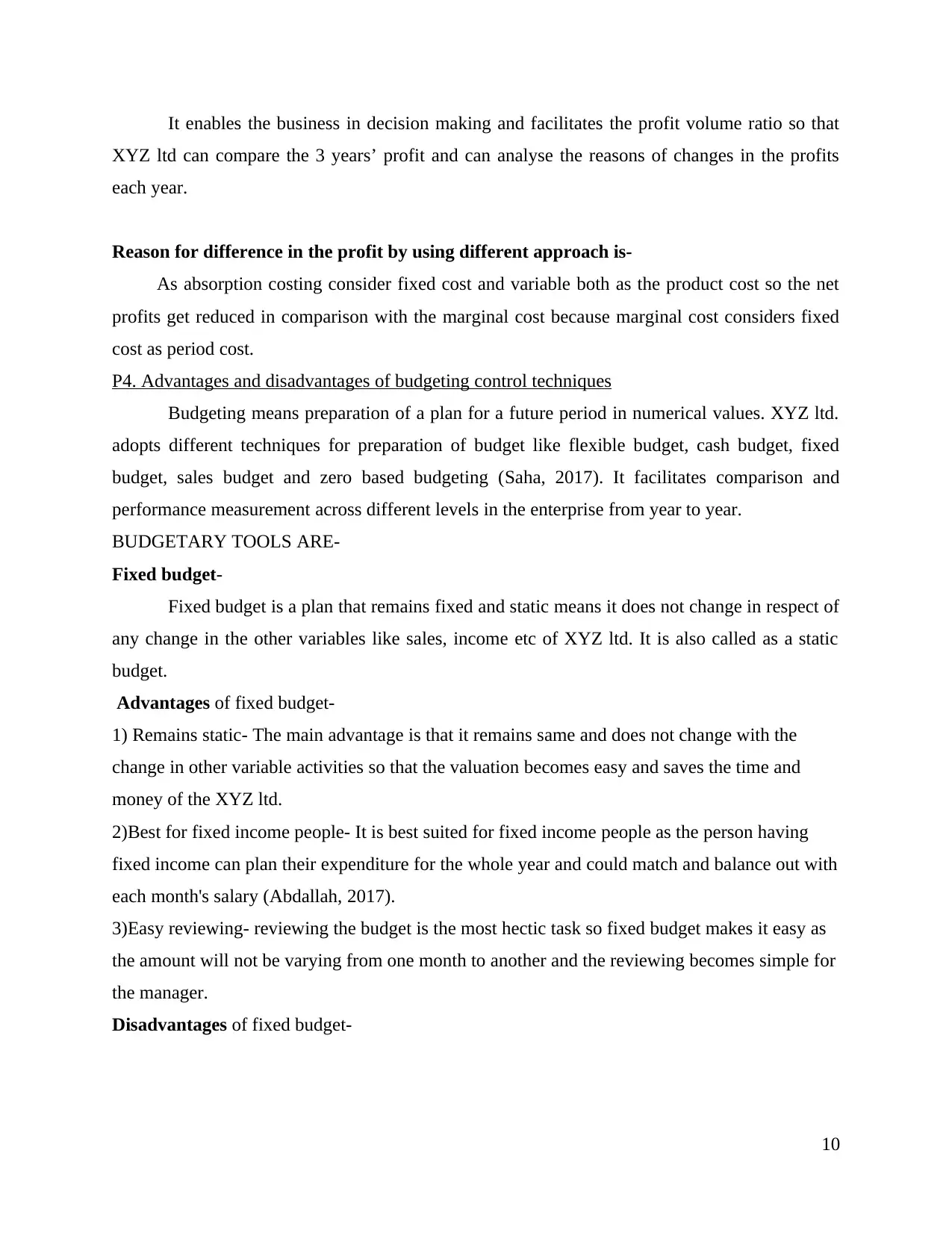
It enables the business in decision making and facilitates the profit volume ratio so that
XYZ ltd can compare the 3 years’ profit and can analyse the reasons of changes in the profits
each year.
Reason for difference in the profit by using different approach is-
As absorption costing consider fixed cost and variable both as the product cost so the net
profits get reduced in comparison with the marginal cost because marginal cost considers fixed
cost as period cost.
P4. Advantages and disadvantages of budgeting control techniques
Budgeting means preparation of a plan for a future period in numerical values. XYZ ltd.
adopts different techniques for preparation of budget like flexible budget, cash budget, fixed
budget, sales budget and zero based budgeting (Saha, 2017). It facilitates comparison and
performance measurement across different levels in the enterprise from year to year.
BUDGETARY TOOLS ARE-
Fixed budget-
Fixed budget is a plan that remains fixed and static means it does not change in respect of
any change in the other variables like sales, income etc of XYZ ltd. It is also called as a static
budget.
Advantages of fixed budget-
1) Remains static- The main advantage is that it remains same and does not change with the
change in other variable activities so that the valuation becomes easy and saves the time and
money of the XYZ ltd.
2)Best for fixed income people- It is best suited for fixed income people as the person having
fixed income can plan their expenditure for the whole year and could match and balance out with
each month's salary (Abdallah, 2017).
3)Easy reviewing- reviewing the budget is the most hectic task so fixed budget makes it easy as
the amount will not be varying from one month to another and the reviewing becomes simple for
the manager.
Disadvantages of fixed budget-
10
XYZ ltd can compare the 3 years’ profit and can analyse the reasons of changes in the profits
each year.
Reason for difference in the profit by using different approach is-
As absorption costing consider fixed cost and variable both as the product cost so the net
profits get reduced in comparison with the marginal cost because marginal cost considers fixed
cost as period cost.
P4. Advantages and disadvantages of budgeting control techniques
Budgeting means preparation of a plan for a future period in numerical values. XYZ ltd.
adopts different techniques for preparation of budget like flexible budget, cash budget, fixed
budget, sales budget and zero based budgeting (Saha, 2017). It facilitates comparison and
performance measurement across different levels in the enterprise from year to year.
BUDGETARY TOOLS ARE-
Fixed budget-
Fixed budget is a plan that remains fixed and static means it does not change in respect of
any change in the other variables like sales, income etc of XYZ ltd. It is also called as a static
budget.
Advantages of fixed budget-
1) Remains static- The main advantage is that it remains same and does not change with the
change in other variable activities so that the valuation becomes easy and saves the time and
money of the XYZ ltd.
2)Best for fixed income people- It is best suited for fixed income people as the person having
fixed income can plan their expenditure for the whole year and could match and balance out with
each month's salary (Abdallah, 2017).
3)Easy reviewing- reviewing the budget is the most hectic task so fixed budget makes it easy as
the amount will not be varying from one month to another and the reviewing becomes simple for
the manager.
Disadvantages of fixed budget-
10
⊘ This is a preview!⊘
Do you want full access?
Subscribe today to unlock all pages.

Trusted by 1+ million students worldwide
1 out of 16
Related Documents
Your All-in-One AI-Powered Toolkit for Academic Success.
+13062052269
info@desklib.com
Available 24*7 on WhatsApp / Email
![[object Object]](/_next/static/media/star-bottom.7253800d.svg)
Unlock your academic potential
Copyright © 2020–2025 A2Z Services. All Rights Reserved. Developed and managed by ZUCOL.





